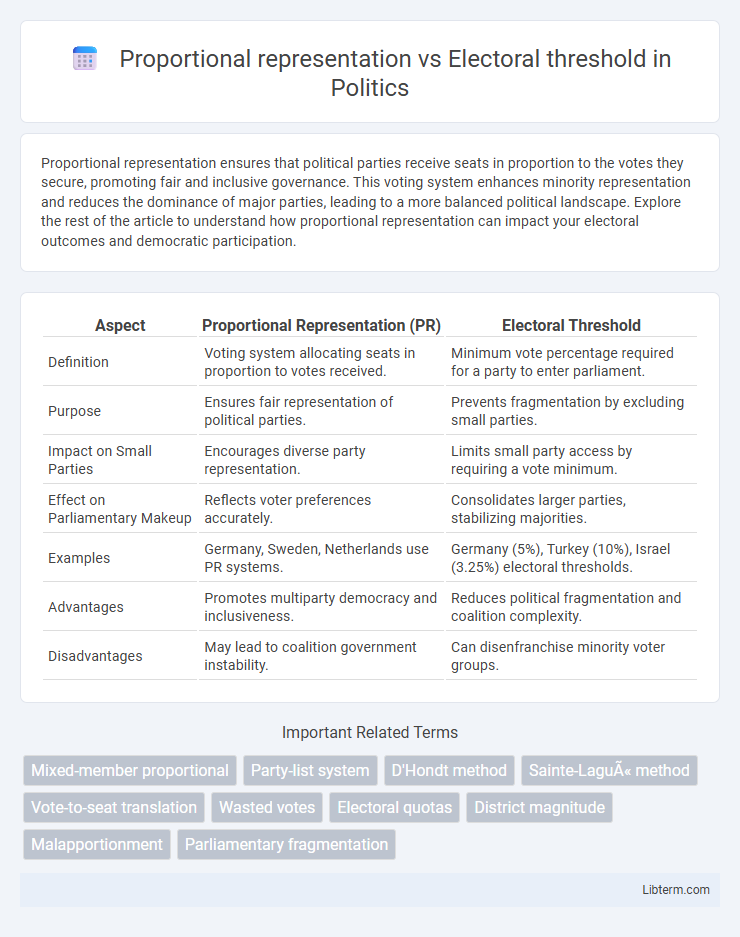Proportional representation ensures that political parties receive seats in proportion to the votes they secure, promoting fair and inclusive governance. This voting system enhances minority representation and reduces the dominance of major parties, leading to a more balanced political landscape. Explore the rest of the article to understand how proportional representation can impact your electoral outcomes and democratic participation.
Table of Comparison
| Aspect | Proportional Representation (PR) | Electoral Threshold |
|---|---|---|
| Definition | Voting system allocating seats in proportion to votes received. | Minimum vote percentage required for a party to enter parliament. |
| Purpose | Ensures fair representation of political parties. | Prevents fragmentation by excluding small parties. |
| Impact on Small Parties | Encourages diverse party representation. | Limits small party access by requiring a vote minimum. |
| Effect on Parliamentary Makeup | Reflects voter preferences accurately. | Consolidates larger parties, stabilizing majorities. |
| Examples | Germany, Sweden, Netherlands use PR systems. | Germany (5%), Turkey (10%), Israel (3.25%) electoral thresholds. |
| Advantages | Promotes multiparty democracy and inclusiveness. | Reduces political fragmentation and coalition complexity. |
| Disadvantages | May lead to coalition government instability. | Can disenfranchise minority voter groups. |
Introduction to Proportional Representation
Proportional representation is an electoral system designed to allocate seats in legislative bodies in direct proportion to the number of votes each party receives, enhancing fairness and diversity in representation. Unlike majoritarian systems, it allows smaller parties to gain legislative seats without securing a majority of votes, thus promoting multiparty democracy and reducing wasted votes. Electoral thresholds, commonly set between 3% and 5%, are used in proportional systems to prevent excessive fragmentation by excluding parties that do not reach a minimum vote share, balancing inclusiveness with governability.
Defining Electoral Thresholds
Electoral thresholds are minimum vote percentages that political parties must achieve to gain representation in proportional representation systems, preventing fragmentation in legislatures. These thresholds vary by country, commonly ranging from 3% to 5%, influencing the number of parties that enter parliament and affecting government stability. Lower thresholds enable smaller parties to gain seats, while higher thresholds foster larger party coalitions and reduce legislative complexity.
Historical Evolution of Voting Systems
Proportional representation emerged in the early 20th century as a response to the limitations of majoritarian systems, aiming to allocate seats based on the percentage of votes each party receives, thereby enhancing political diversity. Electoral thresholds were later introduced to prevent excessive fragmentation in legislatures by requiring parties to receive a minimum percentage of votes to gain representation, balancing inclusivity with governance stability. The historical evolution of voting systems reflects ongoing efforts to reconcile fair representation with effective parliamentary function, shaping modern democracies worldwide.
Key Advantages of Proportional Representation
Proportional representation ensures that political parties receive seats in the legislature closely matching their share of the popular vote, promoting fairer and more accurate representation of diverse voter preferences. This electoral system enhances political inclusivity by enabling smaller parties to gain parliamentary seats, fostering a multiparty landscape and reducing wasted votes. By encouraging broader participation, proportional representation strengthens democratic legitimacy and supports coalition-building, which can lead to more consensus-driven governance.
Drawbacks and Challenges of Proportional Representation
Proportional representation often leads to fragmented parliaments with multiple small parties, making coalition governments unstable and decision-making slower. The absence of a strong electoral threshold can result in fringe parties gaining seats, potentially causing political polarization and legislative gridlock. This system may also dilute accountability as voters struggle to identify clear winners or leaders from numerous competing parties.
Purpose and Impact of Electoral Thresholds
Electoral thresholds serve as minimum vote percentage requirements that parties must exceed to gain seats in proportional representation systems, preventing excessive fragmentation in legislatures. By limiting representation to parties with significant support, thresholds promote political stability and streamline decision-making processes. However, high thresholds can marginalize smaller or emerging parties, impacting the diversity of political representation and voter choice.
Comparing Representation: Inclusivity vs Stability
Proportional representation systems enhance inclusivity by allocating seats based on the percentage of votes each party receives, allowing for diverse political voices and minority groups to be represented. Electoral thresholds, typically set at 3-5%, aim to ensure stability by preventing excessive fragmentation in legislatures and reducing the influence of fringe parties. Balancing proportionality with electoral thresholds affects the trade-off between broad representation and efficient governance.
Case Studies: Countries Using Proportional Representation with Thresholds
Countries like Germany and Israel implement proportional representation systems combined with electoral thresholds to balance political diversity and government stability. Germany's 5% threshold prevents fragmentation by excluding fringe parties from the Bundestag, while Israel's 3.25% threshold similarly shapes party competition and coalition dynamics. These case studies demonstrate how thresholds in proportional systems can streamline parliamentary representation while maintaining inclusivity.
Debates: Fairness, Fragmentation, and Governance
Proportional representation ensures fairer reflection of voter preferences by allocating seats based on vote share, while electoral thresholds prevent excessive fragmentation by excluding small parties from parliament. Debates focus on balancing fairness--where low thresholds increase representation diversity--and governance stability, as high thresholds promote stronger majorities but risk marginalizing minority views. Political systems continuously navigate this trade-off to optimize both inclusive representation and effective decision-making.
Future Trends in Electoral System Design
Future trends in electoral system design emphasize balancing proportional representation with electoral thresholds to enhance both fairness and governability. Increasingly, hybrid models seek to ensure diverse party representation while preventing fragmentation caused by low thresholds. Advances in digital voting technology and data analytics enable more precise calibration of thresholds, promoting stability without sacrificing inclusivity.
Proportional representation Infographic

 libterm.com
libterm.com